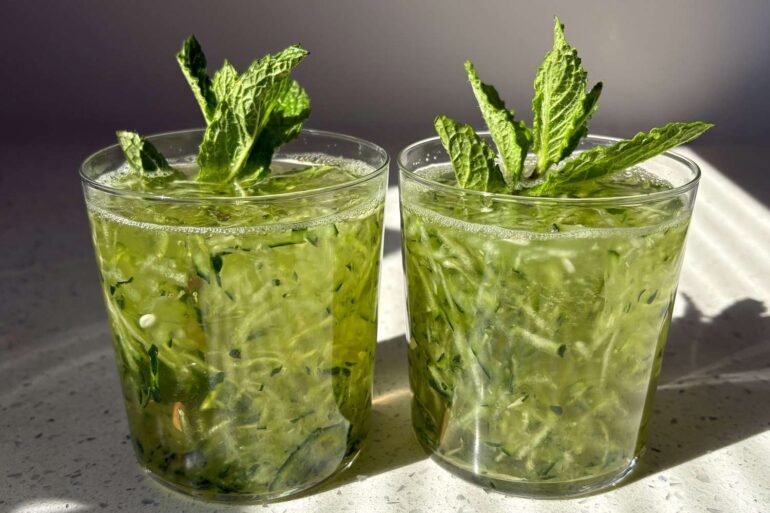:max_bytes(150000):strip_icc():format(jpeg)/Sekanjabin-Ancient-Persian-Drink-FT-BLOG0925-f16ae565fe0340f6ab757467d6a3b582.jpg)
- Sekanjabin is a traditional Persian syrup made from vinegar, honey or sugar, and fresh mint, often served over ice with grated cucumber as a cooling summer drink.
- With roots in medieval medicine, the syrup was prescribed by Avicenna and others for fevers, asthma, and digestive issues, with each ingredient chosen for its balancing properties.
- Today, sekanjabin remains a cultural staple in Iranian households, enjoyed as a refreshing drink, a dip for lettuce, or even a salad dressing, and it is gaining international recognition.
On balmy summer days, you’ll often see Persians sip from condensed glasses filled with a cordial stuffed with shredded cucumber and bundles of mint. The refreshment is made from an ancient syrup known as sekanjabin, which carries centuries of cultural, medicinal, and culinary significance.
What is sekanjabin?
The syrup is made from white wine vinegar simmered with sugar or honey, and then steeped with fresh mint. After it’s cooled, the cordial is diluted with water and often served over ice.
The syrup has evolved over time.
“These days, sekanjabin is made from just vinegar, sugar, and mint,” says Omid Roustaei, author of Bitter & Sweet: Global Flavors from an Iranian-American Kitchen. Traditionally, he says, the sweetness came from honey, and even earlier from angobīn, “a natural sweet sap found on certain plants in Iran. With sugar and honey now widely available, angobīn is no longer commonly used.”
Those unfamiliar with sekanjabin may be skeptical of the drink, based on its acidic base. “A lot of people are thrown off by the fact that the drink contains vinegar,” says Roustaei.
According to chef and content creator (@theiranianvegan) Mana Shamshiri, the astringency in sekanjabin is intentional. “We add vinegar in order to introduce a subtle acidity,” she says. “The resulting flavor is deliciously sweet, tangy and sharp.”
Roustaei agrees. “It is both tart and sweet at the same time,” he says. This interplay is enhanced by herbal freshness. “The mint accents these flavors perfectly, ensuring the end result is also cooling.”
The medicinal history of sekanjabin
Sekanjabin’s roots extend to medieval medical texts, where it was prescribed for fevers, asthma, and digestive imbalances.
“It was prescribed by Ibn Sina [the philosopher and physician known as Avicenna], and can be found in [his ancient medical book] Canon of Medicine, amongst other medical texts,” says Shamshiri. “Often different variations of sekanjabin were prescribed, depending on the ailment.”
Mana Shamshiri, chef and content creator
“Vinegar balances excess heat in the body and clears toxins, honey or sugar replaces lost electrolytes and helps rehydrate the body, and mint reduces heat, inflammation, and promotes digestion.”
— Mana Shamshiri, chef and content creator
The ingredients were chosen not just for taste, but also for their medicinal properties.
“Traditional Persian medicine, which is still practiced in Iran today alongside modern medicine, is centered around an ancient holistic system that focuses on balancing the body’s four humors,” says Shamshiri. “It teaches that illness comes about when these humors fall out of balance.”
Shamshiri says that each ingredient was chosen to help balance the humors.
“Vinegar balances excess heat in the body and clears toxins, honey or sugar replaces lost electrolytes and helps rehydrate the body, and mint reduces heat, inflammation, and promotes digestion,” she says.
Roustaei adds further context. “In Iranian cuisine, foods are classified as garmi (warming) or sardi (cooling), and meals are carefully balanced to suit the seasons and to support overall health,” he says.
Sekanjabin is considered “sardi,” as it’s thought to cool the body on hot summer days. “It has also been taken medicinally for different issues like fevers and asthma,” says Shamshiri.
How people enjoy sekanjabin today
The preparation of sekanjabin remains a ritual in many Iranian households.
“Vinegar and sugar are combined in a saucepan and gently simmered to create a light syrup,” says Roustaei, describing his preferred method of making sekanjabin. “Once the syrup reaches the right consistency and is still hot, a generous amount of fresh mint is added to infuse its vibrant aroma and flavor. The mint is removed after about 10 minutes, and the syrup is ready to serve.”
A small amount of syrup is then poured over ice before water and grated cucumber are added. For a more textural experience, sparkling water can be used.
“The drink is usually garnished with fresh mint sprigs for a beautiful presentation,” says Roustaei.
Food & Wine / Doan Nguyen
Memories of the drink run deep for many who grew up with it.
“My first memories of sekanjabin go back to playing in the garden with my sister in the height of the summer as a child,” says Shamshiri. “I remember hearing the familiar clink of ice against glass straws that my mother had brought over from Iran. She would carry a tray of tall glasses filled with sekanjabin over to us, and my family would sit in the shade and slowly sip on it. It was so refreshing.”
For many Persians, sekanjabin syrup goes beyond beverages. “We often dip fresh lettuce into the syrup as a snack,” says Shamshiri. The chef also enjoys sekanjabin as a salad dressing, where she adds extra vinegar for a sharper tang.
Sekanjabin is starting to gain global attention. People are sampling it in Persian restaurants, while chefs like Shamshiri and Roustaei are bringing it international acclaim. A recent video that Shamshiri shared on sekanjabin racked up more than four million views.
“I think people are interested in learning about the history and taste of various regional delicacies,” says Shamshiri. “I have even started serving sekanjabin as a mocktail at dinner parties. It is such a pleasure to see other people enjoying our culture.”
Amelia Dhuga
2025-09-16 11:30:00

